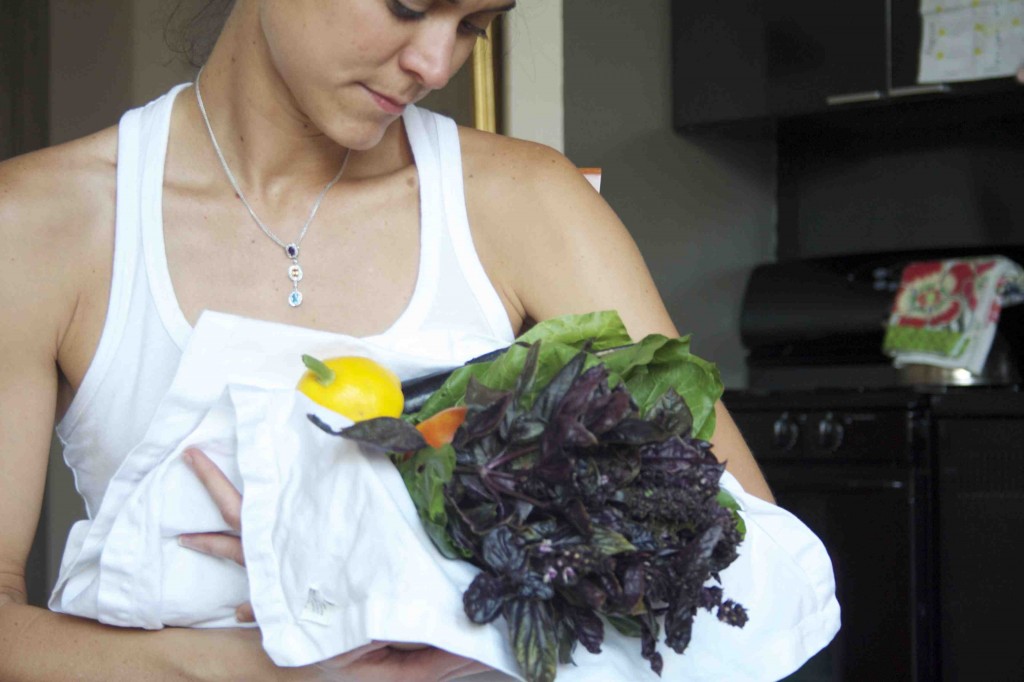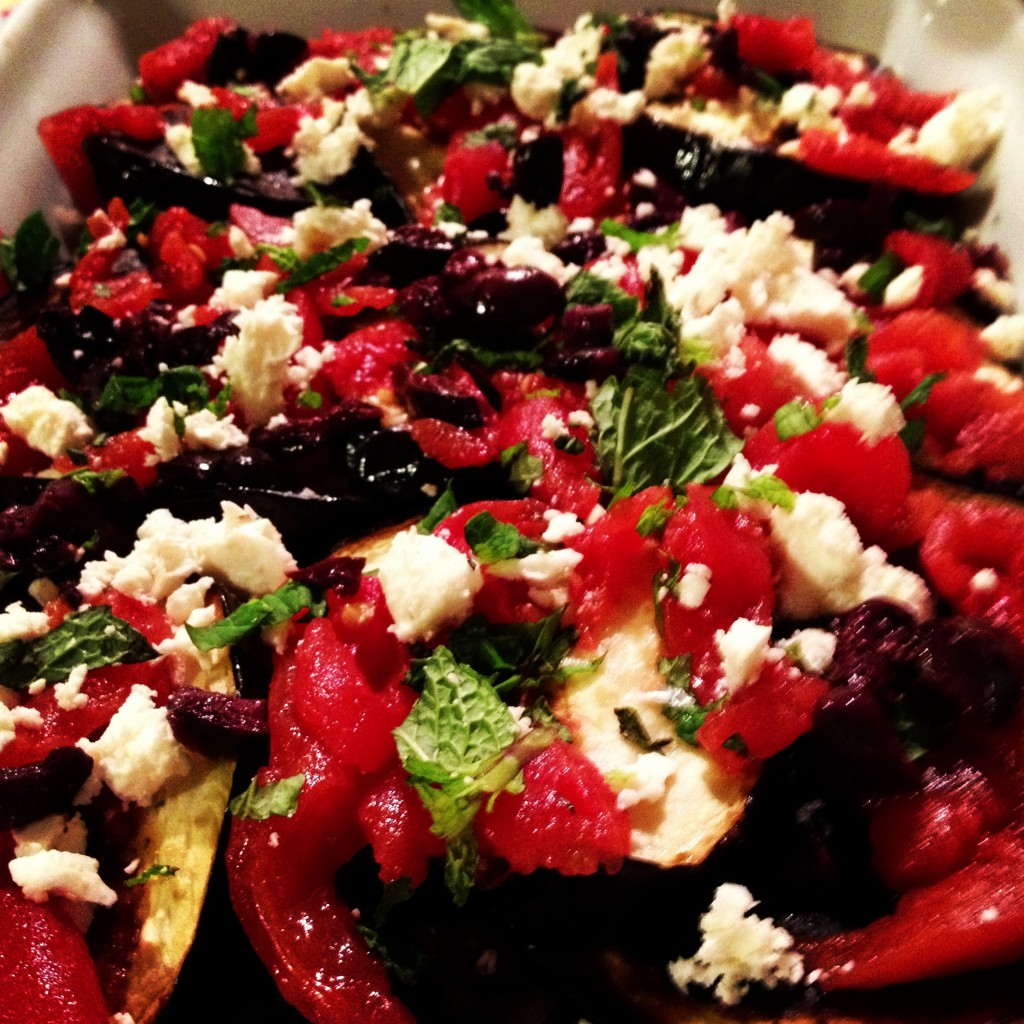Posts Tagged ‘CSA’
The Ever Versatile Aubergine08.12.13
Mom prepared a plate of pickled eggplant or berenjena a la vinagreta with her signature enthusiasm. She simmered the aubergine with a laurel leaf, a pinch of allspice, onion, garlic, and a bouillon cube. After it cooled, she dressed it in a vinaigrette spiked with Worcestershire sauce and oregano, storing it in the refrigerator in a round clear pyrex. My sister loved piling on the silky tangy stuff over crispy saltines, which she snacked on with pure abandon at any time of the day. I, on the other hand, had quite a different relationship to the pickled spread and was far from being a fan.
It’s been surprising to see how all of a sudden this summer, it’s the one vegetable I can’t live without. I’ve sliced and roasted it, layering it with tomatoes and sharp cheese like the Italians do with their melanzane. I’ve diced and tossed it over a high flame with snap peas and ginger to create a hearty and flavorful stir-fry.
Latinfoodie Goes Farm to Table (and needs your help!)11.12.12
We’re down to the last two weeks of our CSA delivery, which means only a few days left to create some scrumptious farm-to-table dishes. This year has proved to be a wonderful one, at least for the produce of Stoneledge Farm, which was spared from disaster of both the hurricane and winter storm that swept across the area the last couple of weeks.
Personally I’ve been trying to keep calm amidst the chaos. Every Tuesday evening I leave work and take the train downtown, pick up my load of fresh veggies, and walk home. When I get home, I sort the produce, decide what to prepare that night, and plan menus for the week. One of the tools I use on a regular basis now is Foodily, a handy food app that helped me find uses for less common ingredients like celeriac and turnip greens, as well as supplied excellent ways to prepare simple soups and stews. Most nights I find a cool recipe on Foodily, prepare it, and end up instagramming the heck out of it:) more »
“YOU GOTTA HAVE A BABY!”07.25.11

Do you remember that Seinfeld episode in which Elaine is surrounded by girlfriends who are telling her that she’s gotta have a baby and move to Long Island? My friend Jess sent it to me this past week, and it got me thinking. It seems like motherhood is knocking on my door in the most unexpected of places.
Every Tuesday morning, Gus and I have the same conversation.”Who’s going to pick them up?”,”Can you pick them up?”, “Are you going to pick them up?”. We’re not talking about babies (yet!), we’re talking about our veggies from the CSA, which we have to pick up every Tuesday night. The thing about the CSA that nobody tells you is that these vegetables become a responsibility. First of all, we have to pick them up before 7 p.m. from the Hudson Guild, which means we have to rush out of work (no later than 6:20 p.m.) if we want to see our vegetables that week. I know what you’re thinking: Why stress over these veggies? Well, we paid a nice and hefty fee back when the year began ($530) to get them, so why not do everything we can to enjoy them?
Don’t get me wrong, the veggies have been great. Last week, I prepared a summer squash and corn soup that had the clearest and most beautiful garden flavors I had tasted all summer. The recipe was included in the weekly newsletter we receive from Stoneledge Farm, which lists the produce of the week, and tips for what to do with it. Last week, I got squash, red onion, dill, eggplant, okra, and green beans. For the soup, I sauteed the squash with onions, poured in some chicken broth, blended it, stirred in some corn, and topped it with feta and lemon. It was unbelievable!
I also have to volunteer at the Chelsea CSA during the course of the summer, which takes place during the work day. They scheduled a trip to the farm, which sounded amazing, but it was on a Friday. So, as you can see, it’s a big commitment, and often work gets in the way. But man, I love those vegetables. When we went out of town this weekend, I thought of them often. “I hope they’re OK. I hope that that they’re OK over the weekend”. And you know what? They were. I got home last night and prepared a big, beautiful summer salad. The romaine was perfectly crispy, the red shallots were firm and plump. I was one proud Mama.
Organics 2.004.02.11
These days, it seems that everywhere you turn, there’s an organic counterpart to a product you’re consuming: shampoo, vegetables, dairy, even cosmetics. Their labels usually market the product as “All Natural” and “100% Organic” and are typically more expensive. But are these products worth the higher cost and most importantly, do they deliver on their claim? Keep reading to discover what you need to know to shop organics the smart way.
It’s easy to shop organic.
FALSE.
In the past few years, manufacturers have leveraged the country’s obsession with healthier eating by producing more organic products. However, for a product to have a USDA-certified organic sticker and be certified organic, it must be composed of at least 95% organic ingredients. Consumers are easily misled by those products with the word “organic” on their label, and often end up paying more for a product that has organic ingredients, but isn’t certified organic.
Diane Hoch, nutritional health counselor and founder of Food Evolution, a nutrition and cooking center in Bardonia, New York, defines the word “organic” in simple terms: “Organic is how nature intended food to be.” When shopping for produce, she suggests looking at the PLU sticker. A number 9 in front of the 4-digit number indicates the product is organic; an 8 indicates that the product has been genetically modified (yuck!).
In shopping for poultry, she recommends you look for “Free Range Organic” on the label or labeling that says “Hormone Free, Antibiotic Free” or “raised on a vegetarian diet without the use of hormones, antibiotics, steroids”. Ideally, beef should be “Grass Fed Organic” and/or purchased directly from a farm.
Organic food means more healthful food.
DEPENDS.
Organic food is food that hasn’t’ been grown using pesticides or chemical additives. It is food that doesn’t come from GMO’s (genetically modified organisms) that have been developed inside a lab, instead of in an open field. Traditionally, food was farmed in a system of rotating crops that would attract pollinators and give the earth time to replenish itself. Contemporary industrial agriculture subsists on a monoculture focused mostly on the crops of corn and soy. Thus, farmers have had to resort to using chemicals and pesticides in order to grow their crops because the earth is literally exhausted.
Virginia Schiffino, former Associate Professor of the NYU Food Studies Program, believes that organic good doesn’t equal healthful food, since now organic versions of junk food are now readily available. “I’d’ rather buy a nonorganic brussels sprouts than an organic box of cereal,” she says.
You can be eating food that’s organic that doesn’t have organic certification.
TRUE.
When you visit your local fresh market, it’s possible to buy food that’s organic without being organically certified. There are costs involved in acquiring an organic certification, so those producers whose annual sales don’t exceed $5,000 are exempted from the certification. You can often find this produce at your local farmer’s market, or at CSA’s (Community Supported Agriculture) programs, where it’s possible to visit the farm and ask the farmer directly about the kind of growing methods that are used.
Products need to be made with 100% organic materials to be labeled organic.
FALSE.
In order to be labeled organic, a product must have at least 95% organic ingredients. If it has 70%, the product can be labeled as “made with organic ingredients”. The National Organic Program (NOP) is the federal regulatory agency governing organic food, administered by the USDA. The Organic Food Production Act of 1990 required the USDA develop national standards for organic products, which covers production, processing, delivery and sale of organic products.
When a product is not organic, you can automatically assume that it has some GMO components.
TRUE.
GMO’s are genetically modified organisms that have been altered or developed inside a lab. Food that is not certified organic has at least some traces of GMO’s. High fructose corn syrup and hydrogenated oils are examples of GMO’s that are commonly found in most of today’s processed foods. To Schiffino, what is more perplexing is that fact that when something is not organically certified, you don’t know why it’s not. “When something is certified, it’s absolutely clear, but when not, the consumer is lacking in a lot of information,” she says. There are parts of the world in which more transparency exists when it comes to what’s in your food. In Europe, for example, labeling requirements specify that manufactures have to let consumers know the ingredients that are GMO’s.
You should stay away from the “Dirty Dozen” to reduce pesticides in your diet.
TRUE.
There’s a list of produce that is more prone to absorbing pesticides because of its soft outer layer. These fruits and vegetables have been labeled the “Dirty Dozen”, which include the following:
Celery
Peaches
Strawberries
Apples
Domestic blueberries
Nectarines
Sweet bell peppers
Spinach, kale and collard greens
Cherries
Potatoes
Imported grapes
Lettuce
Source: Environmental Working Group 2010
Jessica Solt, a writer in New York City has been shopping organic for about 1 ½ years. Her wake-up call came after watching the movie Food, Inc, which led her to realize that the food industry was “being tampered with”. For her, it’s money that’s well spent. “If there’s something you can control, it’s that.”
So next time you prepare your sofrito, try to make it with organic celery instead.



Food For Thought